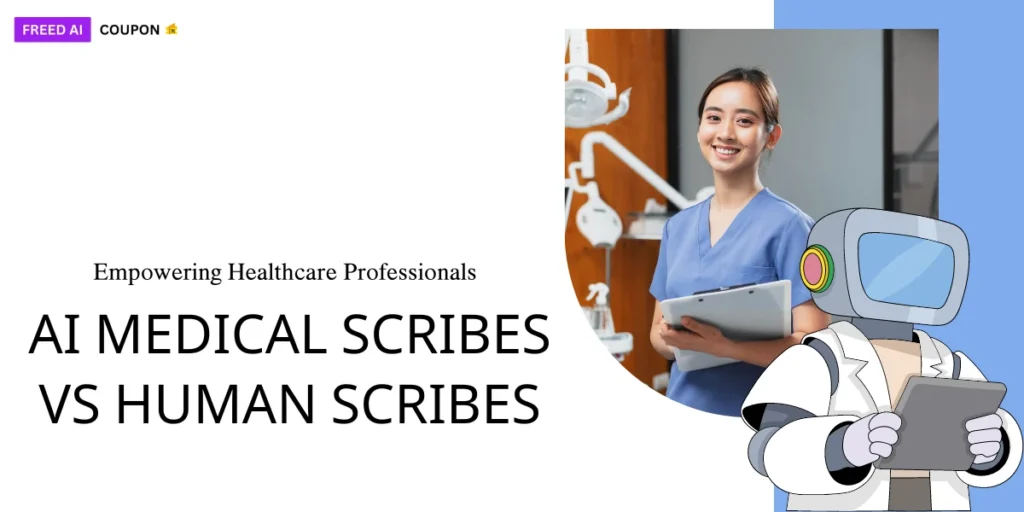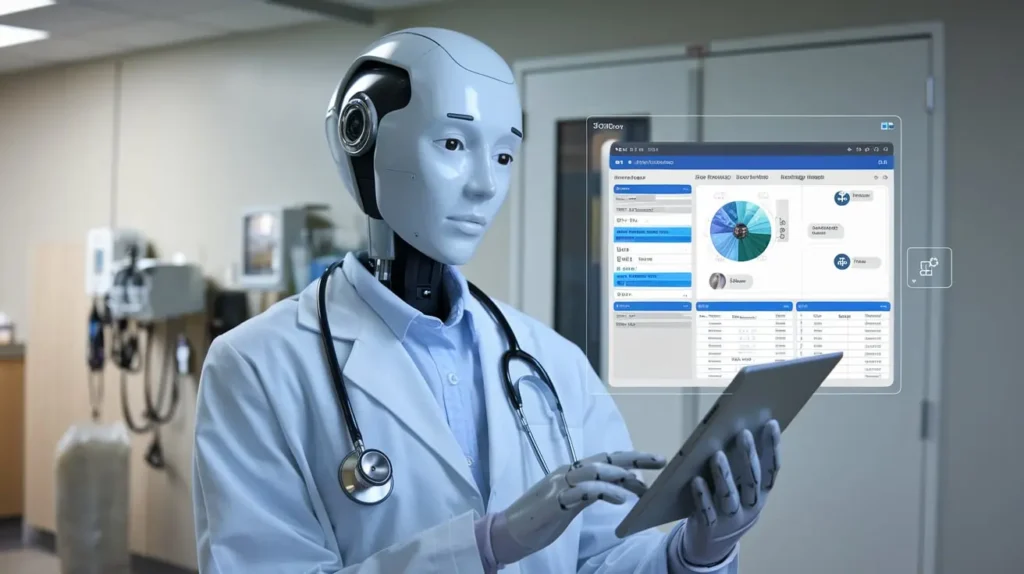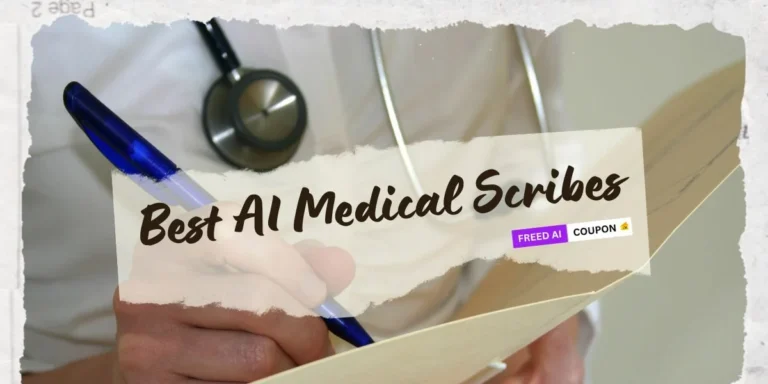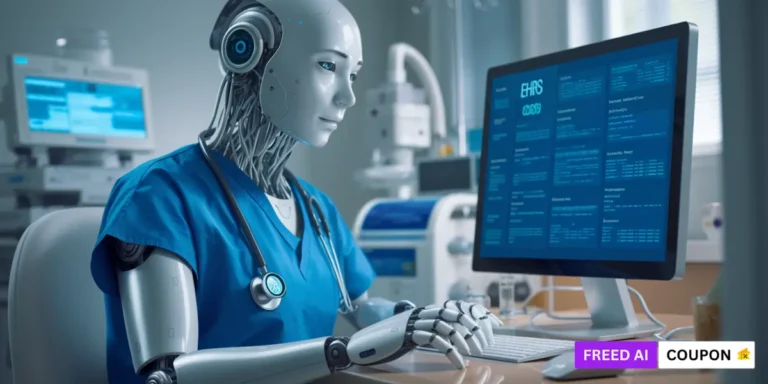
Clinical documentation is a crucial cog in the healthcare machine, though it's often a headache for doctors and nurses. Enter AI medical scribes, a new player in the game, promising to ease these woes. This article gives a run-down of AI medical scribes vs human scribes, weighing what each brings to the table.
Tailored for healthcare pros—whether they're wearing stethoscopes or scrubs—this deep dive aims to show how these tools can up productivity, cut down on paperwork costs, and help you make smarter calls in the clinic.
In the sections that follow, we’ll weigh the pros and cons of AI Medical Scribes vs Human Scribes in our feature comparison. This will help docs and nurses decide how best to fold these solutions into their daily routine.
What are AI Medical Scribes?
AI medical scribes are advanced software systems that utilize natural language processing and machine learning algorithms to automate clinical documentation. These virtual assistants can transcribe and interpret doctor-patient conversations, generate clinical notes, and update electronic health records in real-time.

How AI Scribes Work
Human Medical Scribes: The Traditional Approach
Human medical scribes have been an integral part of healthcare teams for years. These trained professionals work alongside physicians, documenting patient encounters and managing electronic health records. Advantages of human scribes:
Feature Comparison: AI Medical Scribes vs Human Scribes

In healthcare, AI medical scribes and human scribes both help get clinical paperwork in order. Let's break down how these two stack up against each other.
| Feature | AI Scribes | Human Scribes |
|---|---|---|
| Efficiency | AI scribes whip through clinical notes with the magic of Natural Language Processing (NLP) and machine learning, often wrapping up shortly after the patient leaves. | Human scribes do it the old-fashioned way—by hand—which can take longer, sometimes causing hiccups. |
| Consistency and Accuracy | AI scribes stick to the script, delivering notes that fit a clinician's way of working, and enhancing medical coding. | Human scribes' accuracy is a mixed bag; it can depend on their training and biases. |
| Cost | AI scribes trim costs by cutting down on human hours. Sure, there's a start-up bill, but it’s worth it. | Humans bring ongoing expenses like salaries and need constant training, making them a pricier choice over time. |
| Patient Engagement | AI scribes jazz up patient interaction by customizing reports and instructions, suiting each patient's understanding and needs. | Humans offer a more personal touch, often making patients feel at ease with a friendly face. |
| Integration with EHR | AI scribes smoothly hook into Electronic Health Records (EHR), streamlining the process. | Human scribes can manage EHRs, but results vary based on their familiarity with different systems. |
| Provider Burnout | AI scribes take over the grunt work, helping doctors avoid burning out. | Human scribes lift some weight from the doctors' shoulders too, but can't keep up with AI's pace. |
| Adaptability and Training | AI scribes quickly pick up new medical terms thanks to constant software updates. | Humans need regular training to stay current—teaching them can burn time and money. |
| Technology Readiness | AI scribes are getting smarter, though many are still learning the ropes in complex medical areas. | Human scribes are ready to go, no tech hang-ups here. |
This comparison shines a light on what AI and human scribes each bring to the table, their pros and cons, so healthcare folks can pick what suits their needs best.
Advantages and Limitations
AI Scribes
AI scribes sure do bring a lot to the table for healthcare rockstars:
- Boosted Clinician Productivity: With AI scribes on the scene, doctors can kick back a little 'cause they're not buried in paperwork. These digital pals chug through loads of info fast—the sort that takes humans forever—and spit out thorough notes in the blink of an eye. Docs get to wrap up notes faster and fine-tune those pesky medical codes.
- Savings on Documentation Costs: You won't be needing as many humans to scribe away, which means your wallet feels less of a pinch. AI scribes are tireless machines that don't need coffee breaks, and oopsie moments are few and far between. So, bye-bye to those annoying errors on medical records.
- Fancy Features: AI scribes are full of surprises. Not only do they handle different note types and help docs with verbal cues during visits, but they've also got a knack for jazzing up clinical documentation. They gel well with other techy stuff too.
- Better Patient Adherence: With AI scribes jotting down post-visit recaps like they did it just for Oprah, patients get what they understand. Custom summaries that get green lights on authorization requests help patients stick to the plan.
| Challenge | Description |
|---|---|
| Potential for inaccurate notes | While AI scribes are highly accurate, there is still a risk of generating inaccurate or incomplete notes, especially in complex medical scenarios. |
| Outdated medical terminology | AI systems may struggle with understanding and incorporating the latest medical terminology, requiring regular updates and maintenance. |
| Limited contextual understanding | AI scribes may miss subtle nuances and contextual cues that are easily picked up by human scribes. |
Human Scribes
Human scribes still have their perks and quirks:
- More Chat Time with Patients: With human scribes doing the grunt work, docs can actually, you know, talk to their patients instead of wrestling with those clunky EHRs. More face-to-face time makes for happier patients.
- That Human Touch: Empathy's something you won't find in a circuit board. Human scribes get the vibe of patient interactions, keeping trust in tip-top shape.
- Learning Curve for AI: Not everyone in the white coat club has dabbled in AI tech. More learning and solid guidelines are gonna be key to meshing these tech tools with healthcare.
- Flexible Human Brain: Sure, AI's a whiz at routine stuff, but when unpredictable scenarios hit, human scribes step up with their thinking caps on. They're adaptable like that.
| Challenge | Description |
|---|---|
| Human error and fatigue | Human scribes are prone to errors and fatigue, which can impact the accuracy and completeness of clinical notes. |
| Availability and scheduling issues | Ensuring a sufficient number of human scribes to meet the demands of a healthcare organization can be challenging, leading to potential coverage gaps. |
| Higher long-term costs | Employing human scribes involves ongoing expenses such as salaries, benefits, and training costs, which can add up over time. |
AI and human scribes both have their spots in healthcare. Mixing their strengths can tune-up efficiency, nail down accuracy, and polish up patient care like a pro.
The Hybrid Approach: Combining AI and Human Expertise
A hybrid approach that combines the strengths of both AI and human scribes can offer the best of both worlds. By leveraging AI technology for routine documentation tasks and utilizing human scribes for complex cases and personalized support, healthcare organizations can optimize their medical scribing processes.
Examples of Successful Hybrid Implementations
Several healthcare institutions have successfully implemented hybrid models:
- Virtual scribing platforms that integrate AI and human scribes
- AI-assisted documentation with human review and quality control
- Collaborative workflows between AI scribes and human scribes
A large urban hospital reduced documentation time by 40% using a combination of AI transcription and human scribe review.
– Case Study
Conclusion
Healthcare's always on the move, and with AI medical scribes entering the scene, medical documentation is changing for the better. These tech wonders, built to smoothen and speed up paperwork, have already become must-haves for medical folks. Our deep dive into AI Medical Scribes vs Human Scribes: a analysis sheds light on the strengths and quirks of each option in a hospital or clinic setting.
AI scribes shine by crunching massive data amounts, spitting out precise, instant records, and slashing mistakes. They're full of tricks like voice cues during check-ups and tools to help docs make smart choices. These boosts could make a real difference in patient care and how clinics run.
| Advantages | AI Scribes | Human Scribes |
|---|---|---|
| Real-time Documentation | ✅ | ✅ |
| Data Integration | ✅ | ❌ |
| Error Rate | Low | Varies |
| Cost Efficiency | ✅ | ❌ |
| Patient Interaction | ❌ | ✅ |
Adding AI into healthcare isn’t a cakewalk though. It might mess with existing clinic routines if not properly slotted in. Plus, reaching top-tier readiness, hinted by a Technology Readiness Level (TRL) under 4 in intense care scenarios, shows we’re still climbing the tech mountain in medicine.
Meanwhile, human scribes bring their own charm with real conversations and understanding, making patients feel comfy and listened to. They help cut docs some slack from the paperwork pile, letting clinics run more smoothly.
Tomorrow's medical paperwork might just be a tag team of AI and human scribes, taking the best of both worlds. If you're thinking about hopping on the AI scribe train, be sure to weigh your practice’s needs, check tech compatibility, and consider the perks down the line.







